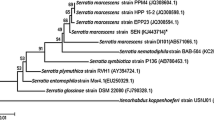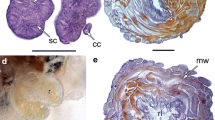Abstract
The larvae of Pimpla turionellae, that develop in pupae of various Lepidoptera, discharged through their anus up to 8μl/h of a hyaline liquid, which is termed “anal secretion”. It exerted a strong bacteriostatic effect on Enterobacter cloacae, a highly virulent intestinal microorganism isolated from the midgut of the host pupa, Pieris brassicae. Growth inhibition of Escherichia coli, Micrococcus luteus and Pseudomonas phaseolicola was also evident, but less pronounced. Inhibition depended upon the concentration of the anal secretion. This was also true regarding the effect on growth of Beauveria bassiana, a fungus pathogenic on insects. The antimycotic action of the anal secretion was less effective against Chaetomium pululiferum, a soil-inhabiting fungus. Growing hyphae of B. bassiana were malformed, exhibiting the so-called “curling effect”, when treated with anal secretion. Parenteral injection of a low dosis of Enterobacter cloacae resulted in 100% mortality of non parasitized pupae of Pieris brassicae; however, simultaneous injection of 3μl of anal secretion resulted in higher survival.
Similar content being viewed by others
References
Brian PW (1949) Studies on the biological activity of griseofulvin. Ann Bot NS 13:59–77
El-Sufty R (1978) Parasitäre Veränderungen der Wirtskutikula durch entomophage Endoparasiten und ihre Bedeutung für Pilzinfektion. Diss Landw Fak Univ Göttingen
Führer E (1975) Über die physiologische Spezifität des polyphagen Puppenparasiten Pimpla turionellae L. (Hym. Ichneumonidae) und ihre ökologischen Folgen. Centralbl gesamte Forstwe 92:218–227
Führer E, Kilincer N (1972) Die motorische Aktivität der endoparasitischen Larven von Pimpla turionellae L. und Pimpla flavicoxis Ths. (Hym. Ichneumonidae) in der Wirtspuppe. Entomophaga 17:149–163
Führer E, El-Sufty R, Willers D (1978) Antibiotic effects of entomophagous endoparasites against microorganisms within the host body. 4th Int Congr Parasitol Warszawa
Haydak HM (1936) A food for rearing laboratory insects. J Econ Ent 29:1026
Kilincer N (1975) Untersuchungen über die hämocytere Abwehrreaktion der Puppe von Galleria mellonella L. (Lep.) und über ihre Hemmung durch den Puppenparasiten Pimpla turionellae L. (Hym. Ichneumonidae). Z Ang Ent 78:340–370
Müller-Kögler E (1965) Pilzkrankheiten bei Insekten. Paul Parey, Berlin Hamburg
Reichert W (1978) Einführung in die Gewässer-Mikrobiologie Fischer, Stuttgart
Rhodes ME (1959) Characterization of Pseudomonas fluorescens. J Gen Microbiol 21:221–263
Salt G (1970) The cellular defence reactions of insects. Cambridge Univ. Press
Willers D (1974) Untersuchungen über die physiologische Eignung verschiedener Schmetterlingspuppen als Wirte für Puppenparasiten Pimpla turionellae L. Dipl Arbeit Forstl Fak Univ Göttingen
Willers D (1980) Untersuchungen über die physiologische Eignung einiger Schmetterlingsarten als Wirte der polyphagen Puppenparasiten Pimpla turionellae L. und Itoplectis conquisitor Say. unter besonderer Berücksichtigung der Larvenmortalität der Parasiten. Diss Forstl Fak Univ Göttingen
Author information
Authors and Affiliations
Rights and permissions
About this article
Cite this article
Willers, D., Lehmann-Danzinger, H. & Führer, E. Antibacterial and antimycotic effect of a newly discovered secretion from larvae of an endoparasitic insect, Pimpla turionellae L. (Hym.). Arch. Microbiol. 133, 225–229 (1982). https://doi.org/10.1007/BF00415006
Received:
Accepted:
Issue Date:
DOI: https://doi.org/10.1007/BF00415006




